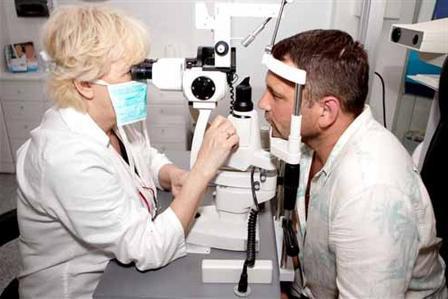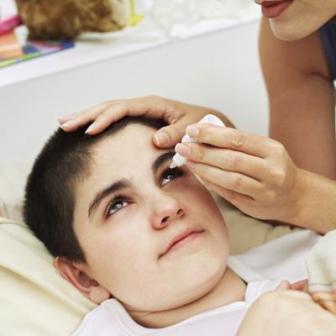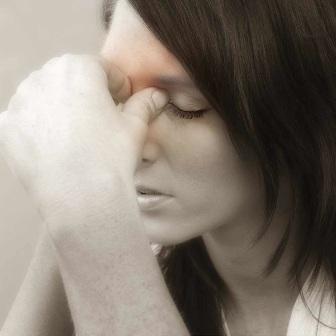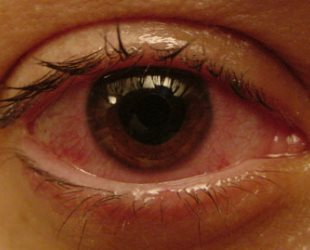Uveitis - inflammation choroid eyes (uveal tract). This disease is common cause low vision and blindness (about 25%). If you have uveitis, you should urgently consult an ophthalmologist. The main symptoms of the disease are “fog” before the eyes, blurred vision (even possible total blindness), eye redness, photophobia and lacrimation
A characteristic feature of the choroid is the absence nerve endings, therefore uveitis for a long time may occur without obvious symptoms and are not accompanied by the appearance pain. Manifestations of the disease depend on the cause of uveitis, the extent of the lesion, the pathogenicity of microorganisms and the condition immune system sick.
Anterior uveitis in initial stage The disease can manifest itself as a feeling of “veil”, a slight “fog” before the eyes, which is accompanied by a feeling of heaviness in the eye and a gradual decrease in visual acuity. If the patient does not see a doctor, as the inflammation progresses, severe redness of the eye appears, vision continues to decline, heaviness and pain in the eye intensify, and indicated symptoms Photophobia, lacrimation, and increased intraocular pressure occur. In severe advanced cases of uveitis, blindness may be a possible outcome of the disease.
Posterior uveitis is characterized by a late onset of symptoms, absence of pain, and no redness of the eyes. There is a gradual progressive deterioration of vision, with the appearance of a “fogginess” or “spot” in front of the affected eye. As inflammation progresses, weak ones may join dull pain in the depths of the eye socket. Usually this sign indicates involvement in the inflammatory process optic nerve.
Most often, the disease occurs due to hypothermia, impaired immunity, metabolism and autoimmune processes, due to the fact that the choroid is involved in inflammation.
If inflammation appears in the anterior parts of the choroid, then the patient is diagnosed with “anterior uveitis,” which affects the ciliary body and the iris of the eye. In the case when the inflammatory focus forms in the posterior parts of the uveal tract, the diagnosis is characterized as posterior uveitis, which negatively affects the optic nerve, retina and choroid. However, there are cases when inflammation affects all uveal tracts, then such pathological condition called panuveitis. In most cases, the disease affects one eye, and peripheral uveitis causes floaters and reduces vision in both eyes.
Very often the causes of the disease are various infectious diseases, such as tuberculosis, syphilis, chlamydia, toxoplasmosis and brucellosis.
Unfortunately, the disease can be caused even systemic diseases such as ankylosing spondylitis, rheumatism, Reiter's syndrome, rheumatoid arthritis etc. Oddly enough, sometimes uveitis is caused by reasons that even experienced specialists cannot determine.
The treatment regimen for uveitis depends on the etiology and type of disease. However, for any form of inflammation symptomatic treatment uveitis involves preventing structure destruction vitreous eyes and lens. For this purpose, the patient is prescribed solutions of Atropine, Scopolamine, Adrenaline, etc.
In the drug treatment of uveitis streptococcal etiology antibiotics are used wide range actions, corticosteroids and vitamin therapy. Fading inflammatory process occurs approximately on the 3-5th day of treatment for ocular uveitis.
For ocular uveitis due to toxoplasmosis, therapy is carried out with Sulfadimezine and Chloridine. Treatment of uveitis of this form continues for at least 2 weeks with constant monitoring of the patient’s kidney and blood condition.
Uveitis of tuberculous etiology is treated with anti-tuberculosis chemotherapy. In especially severe cases, with significant destruction of the vitreous body of the eye, surgical treatment of uveitis is sometimes required.
As a rule, the treatment of pathology is an extensive set of measures. Treatment methods depend on the etiology of the process and its localization:
Except drug treatment, physioreflexotherapy is prescribed. Sometimes shown surgery(both traditional and laser surgery). Treatment of uveitis requires medical examination of the patient; after completion of treatment, patients who have had inflammation of the choroid should undergo dispensary observation, the period of which is at least two years.
Treatment of uveitis with folk remedies should be carried out with extreme caution, otherwise the situation may worsen.
What are possible symptoms anterior uveitis (iritis, iridocyclitis)? The first sign of inflammation of the choroid, which may attract attention, is a small and sometimes pronounced corneal syndrome, i.e. photophobia, lacrimation, blepharospasm, redness of the eye with purple tint(pericorneal injection).
By immediately checking the patient’s vision, you can make sure that it is somewhat reduced and does not improve with the use of weak positive or negative glasses. During an eye examination with lateral illumination or biomicroscopy, one can detect “fogging” (dullness) of the corneal endothelium, as well as precipitates varying in number, size, shape, tone (color), and exudate in the aqueous humor of the anterior chamber, varying in type and quantity ( serous, purulent, etc.).
The iris can be discolored, full-blooded (edematous, hyperemic) with newly formed vessels, lumpy (granulomas).
The pupil may be constricted and its reaction to light may be slow. During the “play” of the pupil during lighting and darkening, and later during its expansion with mydriatics, posterior synechiae (adhesions of the pupillary edge of the iris with the anterior lens capsule) and exudate deposits on the lens can be detected.
Finally, with light palpation eyeball its pain is revealed. In addition, there may be a general depressed, restless, uncomfortable state of the patient.
All these symptoms indicate inflammation of the choroid. But to determine whether it is anterior uveitis or more widespread, ophthalmoscopy is performed. If the vitreous body is transparent and there are no changes in the fundus, then the diagnosis of anterior uveitis is beyond doubt.
Uveitis is an inflammation of the choroid of the eye, which manifests itself as pain, hypersensitivity to light, lacrimation, blurred vision.
The uveal tract has complex structure, located between the sclera and the retina, looks like a bunch of grapes. It consists of vessels that supply the eyes nutrients. The uveal tract is formed by the iris, vitreous and ciliary bodies, and the choroid itself.
According to anatomical structure uveal tract is isolated the following types uveitis:
Depending on the nature of inflammation, 4 forms of pathology are distinguished:
By etiological factors Uveitis is usually divided into:
Uveitis can develop as primary disease when it is not preceded by pathological processes. Secondary uveitis is distinguished when the pathology occurs against the background of other eye diseases.
According to the nature of the flow, they are distinguished:
Highlight following reasons development of uveitis:
The disease often develops in patients who have a history of other eye pathologies. In childhood and old age, infectious uveitis is mainly diagnosed, which occurs against the background of allergies or stressful situations.
The clinical picture depends on the localization of the inflammatory process, the state of the immune system, and the nature of the disease. In acute anterior uveitis, patients report the following symptoms:
For chronic inflammation anterior section The uveal tract is characterized by an asymptomatic course. Only in some cases do patients notice slight redness of the eyeballs and the appearance of dots in front of the eyes.
A characteristic sign of peripheral uveitis is damage to both eyes. Patients complain of decreased central vision and the appearance of “floaters” before the eyes.
The following symptoms are typical for posterior uveitis:
It is also possible to develop macular edema, optical neuropathy, macular ischemia, retinal detachment.
Diagnosis of uveitis is carried out by an ophthalmologist. Within initial appointment a specialist must examine the eyes, check visual acuity, visual fields, and conduct tonometry to determine the value of intraocular pressure.
Additionally, the following studies are carried out:
Drug therapy for anterior and posterior uveitis involves the use of the following groups of drugs:
If drug therapy helped eliminate acute inflammation, then physiotherapeutic treatment is indicated. High efficiency have electrophoresis, infitatherapy, laser irradiation blood, vacuum pulse massage, phototherapy, phonophoresis, laser coagulation, cryotherapy.
Development of complications or severe course uveitis requires surgical treatment. The operation may include the following steps:
Surgery does not always have a favorable outcome. In some cases, surgery causes an exacerbation of the inflammatory process.
During the treatment of uveitis, some folk recipes. However, before any manipulation you need to consult your doctor.
The following recipes will help effectively eliminate inflammation:
In the absence effective treatment uveitis can lead to the development of serious eye diseases:
With timely and complex therapy acute inflammation The patient's eyes can be completely cured in 3-6 weeks. However, chronic uveitis is prone to relapses when the underlying pathology worsens, which significantly complicates therapy and worsens the prognosis.
Uveitis is a pathology of the uvea of the eye. inflammatory in nature which can lead to complete loss of vision. Therefore, it is so important to diagnose and begin treatment of the disease in time. Huge value has disease prevention, which involves timely therapy pathological processes in the body, eliminating household eye injuries, allergization of the body.
Ocular uveitis is a large group of diseases characterized by inflammation of the choroid of the organ of vision. The membrane is located between the retina and the sclera; its structure is complex. It has three departments. These are the iris, the ciliary (celiac) body and the thin membrane (choroid), which is adjacent to the sclera and consists of blood vessels. The choroid performs a number of important functions:
protection from excessive light;
participation in (viewing objects at various distances);
production of intraocular fluid;
intraocular pressure support;
regulation of metabolism in the organ of vision;
thermoregulatory function.
It is obvious that the violation coordinated work choroid of the eye leads to serious consequences for the entire organ. Uveitis is one of the most common eye diseases. This pathology occupies 30% of all diseases of the organs of vision.
Depending on the duration, the disease can be acute or chronic (more than six weeks) in nature.
Based on the location of the inflammation, uveitis is divided into four forms:

Manifestations of uveitis are determined by the pathogenicity of the infection, the location of the source of inflammation and, of course, the body’s ability to resist infection. Symptoms of iritis or acute uveitis are light fog before the eyes, redness of the eyeball, increased intraocular pressure, lacrimation, and blurred vision. Manifestations of other forms of the disease, as a rule, are mild or the disease is completely asymptomatic. Usually in this case there is no redness of the organs of vision, pain, or rapid blindness. Vision deteriorates gradually, and a veil or spot is felt before the eyes.
Acute ocular uveitis is especially dangerous. The disease progresses very quickly, and late diagnosis can lead to blindness.
Uveitis can be detected quite early. Timely start competent treatment will help overcome the disease. Diagnosis is carried out exclusively by an ophthalmologist. In order to correctly establish and confirm the diagnosis, specialists use the following methods:

IN medical practice in a special place there is sluggish uveitis of the eye - this is one of the first signs developing disease when the color of the iris changes. Treatment in this case is aimed at speedy resolution of the opacities and elimination of the underlying disease. If you do not pay attention to the first symptoms in time, changes in the color of the iris will be replaced by dystrophy, and then the disintegration of the iris. At timely treatment vision is completely restored, otherwise it is completely lost.
When identifying the infectious nature of the disease, anti-inflammatory and antibacterial drugs in the form of ointments, drops, which are prescribed locally, as well as in the form of tablets and injections for systemic therapy. In addition, it is necessary to use drops that dilate the pupil. It is also recommended to use vasodilators, immunostimulants, and physiotherapeutic treatment has a positive effect. If the patient has increased intraocular pressure, prescribe the use of antiglaucoma drugs. 
To eliminate the disease, you can use proven recipes traditional medicine:
1. Pour three tablespoons of calendula into a glass of boiling water and leave for an hour. Strain the infusion and rinse sore eyes. For the same purpose you can use sage and rose hips.
2. Every morning, treat your eyes with a weak solution of potassium manganese. It is necessary to prepare a new solution every day; to avoid transmission of infection, use separate sterile cotton wool for each eye.
3. To wash the organs of vision, prepare an infusion of dry aloe leaves. You can also use fresh plant juice, after diluting it with boiled water in a ratio of 1:10.
4. To three to four tablespoons (chopped) add a glass of cold boiled water, mix and leave for eight hours. Use the resulting composition for compresses on the eyes.

Uveitis of the eye — enough serious illness, which leads to irreversible consequences, therefore it requires emergency treatment. If there is slight redness of the organ of vision that does not go away within a few days, you should consult an ophthalmologist as soon as possible. After the examination it will be determined correct diagnosis and necessary treatment is prescribed.
Monitor your health, do not ignore the first symptoms of illness. Be healthy!
Uveitis refers to a whole group of eye diseases associated with inflammation in the choroid of the eye (another name is the uveal tract).
The choroid or uvea is represented by three components: the iris (in Latin iris), the ciliary body or ciliary body (in Latin corpus ciliare) and the choroid proper (in Latin chorioidea).
Depending on the location of inflammation, there are following forms uveitis: cyclitis, iritis, iridocyclitis, chorioretinitis, choroiditis, etc. The main danger of this group of diseases is possible consequences in the form of blindness or low vision.
The occurrence of this disease is facilitated by the fact that the vasculature of the eye is very widespread, and the blood flow in the uveal tract is slow, which can lead to the retention of microorganisms in the choroid.
Under certain conditions, these microorganisms can lead to inflammation. The occurrence and development of inflammation is also influenced by other features of the choroid, in particular, different blood supply and innervation of its different structures:
These features determine separate lesions of the anterior and posterior parts of the uveal tract. Either one department or the other may suffer.
Uveitis can occur due to infections, allergic reactions, metabolic disorders, hypothermia, decreased immunity, injuries, common diseases body.
The most common (almost half of the cases) are infectious uveitis. The infection can be caused by mycobacterium tuberculosis, toxoplasma, streptococci, treponema, herpes virus, and fungi. Infection in the choroid can enter from any source of viral diseases, tuberculosis, syphilis, dental caries, tonsillitis, etc.
Allergic uveitis occurs against the background of food and drug allergies.

Uveitis can occur when there is the following diseases body: rheumatoid arthritis, rheumatism, psoriasis, ulcerative colitis, multiple sclerosis, glomerulonephritis, etc.
Uveitis of a traumatic nature may occur due to eye burns, penetrating eye injuries, or exposure to foreign body.
Uveitis may develop against the background hormonal dysfunction and metabolic disorders (menopause, diabetes, etc.), blood diseases, diseases of the organs of vision (scleritis, blepharitis, keratitis, conjunctivitis, retinal detachment, etc.).
The symptoms of each form of uveitis are different.
Anterior uveitis is characterized by the following symptoms:
IN chronic course Anterior uveitis symptoms occur rarely or are mild: only slight redness and floating spots before the eyes.
Peripheral uveitis occurs with the following symptoms:
Posterior uveitis is characterized by late onset of symptoms. They are characterized by:

Timely diagnosis of uveitis is very great value, because if left untreated, dangerous diseases may develop eye pathologies which can lead to complete blindness.
An ophthalmological examination for suspected uveitis may include:
If the causes of uveitis are other diseases of the body, it is necessary to carry out laboratory and functional diagnostics and treatment of these diseases.
The ophthalmologist prescribes treatment for uveitis depending on the type and cause of the disease. Therapy in in this case is aimed at preventing complications that can lead to vision loss.
With timely treatment, mild forms of uveitis disappear within 3-6 weeks.

In severe cases with significant destruction of the vitreous body, it is required surgical treatment uveitis. For iridocyclochoroiditis (or panuveitis), vitreectomy may be performed ( surgical removal vitreous body), and if the eye can no longer be saved, evisceration of the eyeball is performed (all internal structures of the eyeball are removed).
When treating uveitis, you can use some traditional medicine methods, after discussing the possibility of such treatment with your doctor:
To prevent diseases, you should maintain eye hygiene, avoid hypothermia, eye injuries, overwork, and the development of allergies, and promptly treat various diseases of the body. If any eye disease occurs, treatment should be started immediately so as not to provoke the emergence of more serious diseases.
Did the article help? Perhaps it will help your friends too! Please click on one of the buttons:
– a person’s ability to effectively interact with the outside world. Various diseases of these paired organs can lead to decreased and even complete loss of vision. How sad it becomes to realize that a person has done nothing to save own vision. To avoid this, you need to treat any diseases related to the eyes.
The vascular, or uveal, membrane of the eye consists of so-called layers: the iris, ciliary (ciliary) body, vitreous body and choroid. What is uveitis? This is an inflammation of any of the three layers of the choroid (uveal tract) of the eye. Depending on the area of inflammation, one or another disease develops. Sometimes all three layers can become inflamed, leading to complete loss of vision.
The main factor that contributes to the development of uveitis is a certain slowness of blood flow in the ocular uveal tract. If there is an infection in the blood, it has time to attach to the membrane of the eye while the blood flow continues.
There are various types of uveitis to consider:
In most cases, uveitis is provoked by such a cause - an infection that enters the eye through the bloodstream, transferred from another infected organ, or through eye injuries from environment. There can be a variety of bacteria and viruses here. Basically, bacteria penetrate from the outside, and viruses and other microorganisms are carried through the bloodstream.
But let’s not rule out other causes of uveitis:
Let's look at the signs and symptoms of uveitis of the choroid according to the affected areas:
General symptoms of any type of uveitis are:
In children, uveitis often occurs only due to eye injuries. In second place it occurs due to allergic reaction, metabolic diseases or infectious spread. The symptoms here are the same as in adults. You should not self-medicate. It's better to consult a pediatrician.
Adults have their own illnesses, which are not only temporary, but also permanent. Overwork and hypothermia – frequent occurrences in adulthood. Metabolic and rheumatic diseases also occur in men and women. Hormonal imbalances, lack good nutrition, bad habits– everything reduces the body’s resistance. Thus, it is very easy for an adult to develop uveitis.
Diagnosis of uveitis is based on the patient’s complaints and an external examination of the eye by an ophthalmologist. Additionally, studies are carried out to clarify the type of uveitis:
Treatment of uveitis involves not only eliminating the disease, but also preventing the occurrence of complications. The patient is not admitted to the hospital, but he must adhere to the doctor’s recommendations.
How to treat uveitis? Using the following medications:
How else to treat uveitis? Using physiotherapeutic procedures:
If there is no effect from drug treatment, as well as running forms surgical treatment is performed:
Can be used at home folk remedies, if they have been previously discussed with a doctor. Remember that we are talking about your vision, which can be lost if you ignore medical advice and help:
There is no need to follow any diet here. Use more vitamins through food and eliminating alcohol and cigarettes is all that is required of the patient.
How long do people live with uveitis? The disease does not affect life expectancy, but causes significant complications if left untreated:
In order not to lead to such complications and not to suffer from uveitis at all, you should adhere to prevention: